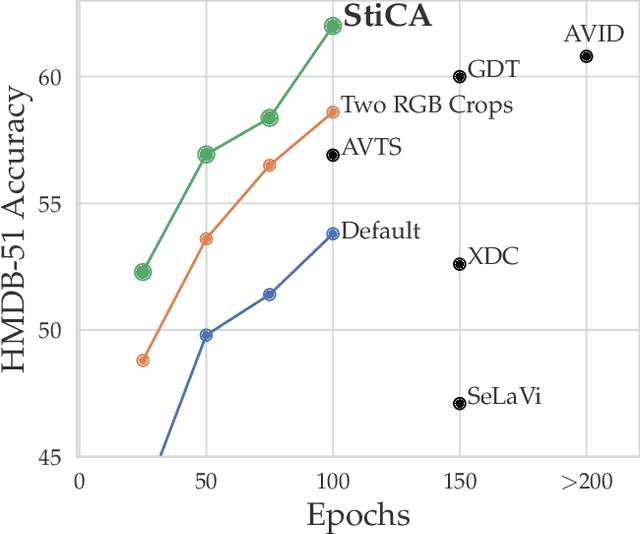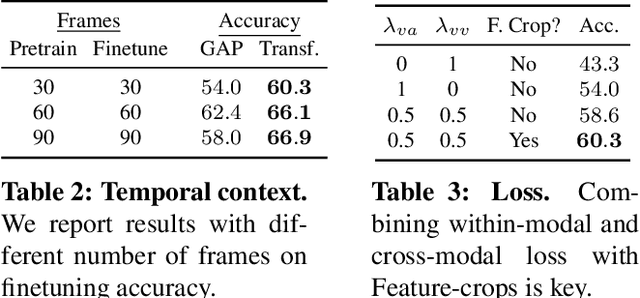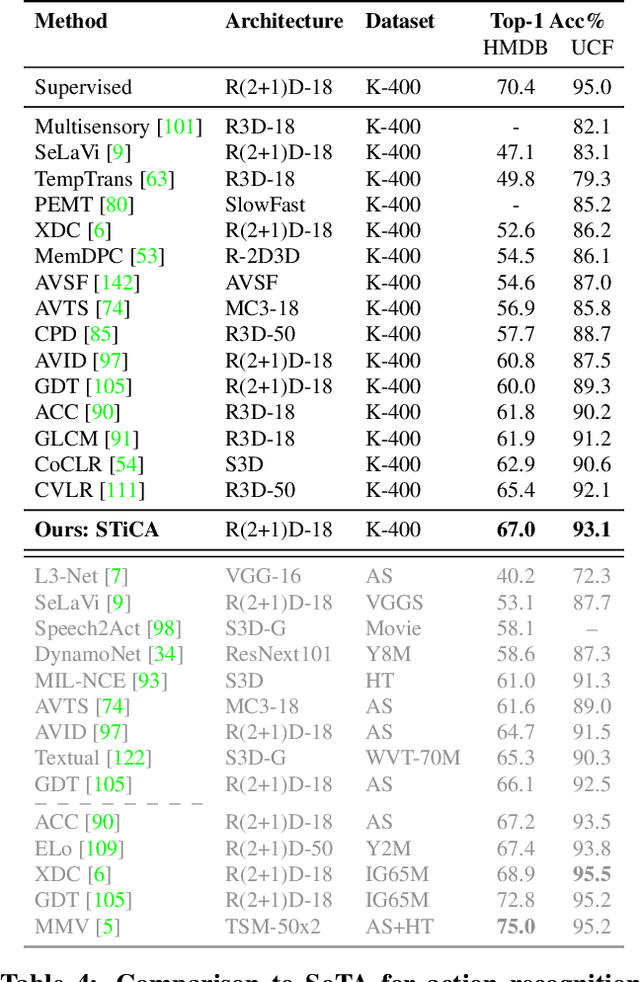Mandela Patrick
Keeping Your Eye on the Ball: Trajectory Attention in Video Transformers
Jun 09, 2021



Abstract:In video transformers, the time dimension is often treated in the same way as the two spatial dimensions. However, in a scene where objects or the camera may move, a physical point imaged at one location in frame $t$ may be entirely unrelated to what is found at that location in frame $t+k$. These temporal correspondences should be modeled to facilitate learning about dynamic scenes. To this end, we propose a new drop-in block for video transformers -- trajectory attention -- that aggregates information along implicitly determined motion paths. We additionally propose a new method to address the quadratic dependence of computation and memory on the input size, which is particularly important for high resolution or long videos. While these ideas are useful in a range of settings, we apply them to the specific task of video action recognition with a transformer model and obtain state-of-the-art results on the Kinetics, Something--Something V2, and Epic-Kitchens datasets. Code and models are available at: https://github.com/facebookresearch/Motionformer
Multilingual Multimodal Pre-training for Zero-Shot Cross-Lingual Transfer of Vision-Language Models
Apr 15, 2021



Abstract:This paper studies zero-shot cross-lingual transfer of vision-language models. Specifically, we focus on multilingual text-to-video search and propose a Transformer-based model that learns contextualized multilingual multimodal embeddings. Under a zero-shot setting, we empirically demonstrate that performance degrades significantly when we query the multilingual text-video model with non-English sentences. To address this problem, we introduce a multilingual multimodal pre-training strategy, and collect a new multilingual instructional video dataset (MultiHowTo100M) for pre-training. Experiments on VTT show that our method significantly improves video search in non-English languages without additional annotations. Furthermore, when multilingual annotations are available, our method outperforms recent baselines by a large margin in multilingual text-to-video search on VTT and VATEX; as well as in multilingual text-to-image search on Multi30K. Our model and Multi-HowTo100M is available at http://github.com/berniebear/Multi-HT100M.
Space-Time Crop & Attend: Improving Cross-modal Video Representation Learning
Mar 18, 2021



Abstract:The quality of the image representations obtained from self-supervised learning depends strongly on the type of data augmentations used in the learning formulation. Recent papers have ported these methods from still images to videos and found that leveraging both audio and video signals yields strong gains; however, they did not find that spatial augmentations such as cropping, which are very important for still images, work as well for videos. In this paper, we improve these formulations in two ways unique to the spatio-temporal aspect of videos. First, for space, we show that spatial augmentations such as cropping do work well for videos too, but that previous implementations, due to the high processing and memory cost, could not do this at a scale sufficient for it to work well. To address this issue, we first introduce Feature Crop, a method to simulate such augmentations much more efficiently directly in feature space. Second, we show that as opposed to naive average pooling, the use of transformer-based attention improves performance significantly, and is well suited for processing feature crops. Combining both of our discoveries into a new method, Space-time Crop & Attend (STiCA) we achieve state-of-the-art performance across multiple video-representation learning benchmarks. In particular, we achieve new state-of-the-art accuracies of 67.0% on HMDB-51 and 93.1% on UCF-101 when pre-training on Kinetics-400.
Support-set bottlenecks for video-text representation learning
Oct 06, 2020



Abstract:The dominant paradigm for learning video-text representations -- noise contrastive learning -- increases the similarity of the representations of pairs of samples that are known to be related, such as text and video from the same sample, and pushes away the representations of all other pairs. We posit that this last behaviour is too strict, enforcing dissimilar representations even for samples that are semantically-related -- for example, visually similar videos or ones that share the same depicted action. In this paper, we propose a novel method that alleviates this by leveraging a generative model to naturally push these related samples together: each sample's caption must be reconstructed as a weighted combination of other support samples' visual representations. This simple idea ensures that representations are not overly-specialized to individual samples, are reusable across the dataset, and results in representations that explicitly encode semantics shared between samples, unlike noise contrastive learning. Our proposed method outperforms others by a large margin on MSR-VTT, VATEX and ActivityNet, for video-to-text and text-to-video retrieval.
Labelling unlabelled videos from scratch with multi-modal self-supervision
Jun 24, 2020



Abstract:A large part of the current success of deep learning lies in the effectiveness of data -- more precisely: labelled data. Yet, labelling a dataset with human annotation continues to carry high costs, especially for videos. While in the image domain, recent methods have allowed to generate meaningful (pseudo-) labels for unlabelled datasets without supervision, this development is missing for the video domain where learning feature representations is the current focus. In this work, we a) show that unsupervised labelling of a video dataset does not come for free from strong feature encoders and b) propose a novel clustering method that allows pseudo-labelling of a video dataset without any human annotations, by leveraging the natural correspondence between the audio and visual modalities. An extensive analysis shows that the resulting clusters have high semantic overlap to ground truth human labels. We further introduce the first benchmarking results on unsupervised labelling of common video datasets Kinetics, Kinetics-Sound, VGG-Sound and AVE.
Multi-modal Self-Supervision from Generalized Data Transformations
Mar 09, 2020



Abstract:Self-supervised learning has advanced rapidly, with several results beating supervised models for pre-training feature representations. While the focus of most of these works has been new loss functions or tasks, little attention has been given to the data transformations that build the foundation of learning representations with desirable invariances. In this work, we introduce a framework for multi-modal data transformations that preserve semantics and induce the learning of high-level representations across modalities. We do this by combining two steps: inter-modality slicing, and intra-modality augmentation. Using a contrastive loss as the training task, we show that choosing the right transformations is key and that our method yields state-of-the-art results on downstream video and audio classification tasks such as HMDB51, UCF101 and DCASE2014 with Kinetics-400 pretraining.
Understanding Deep Networks via Extremal Perturbations and Smooth Masks
Oct 18, 2019



Abstract:The problem of attribution is concerned with identifying the parts of an input that are responsible for a model's output. An important family of attribution methods is based on measuring the effect of perturbations applied to the input. In this paper, we discuss some of the shortcomings of existing approaches to perturbation analysis and address them by introducing the concept of extremal perturbations, which are theoretically grounded and interpretable. We also introduce a number of technical innovations to compute extremal perturbations, including a new area constraint and a parametric family of smooth perturbations, which allow us to remove all tunable hyper-parameters from the optimization problem. We analyze the effect of perturbations as a function of their area, demonstrating excellent sensitivity to the spatial properties of the deep neural network under stimulation. We also extend perturbation analysis to the intermediate layers of a network. This application allows us to identify the salient channels necessary for classification, which, when visualized using feature inversion, can be used to elucidate model behavior. Lastly, we introduce TorchRay, an interpretability library built on PyTorch.
 Add to Chrome
Add to Chrome Add to Firefox
Add to Firefox Add to Edge
Add to Edge